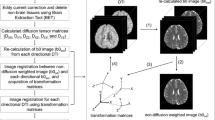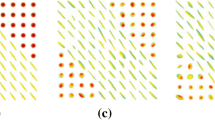Abstract
Purpose
In diffusion tensor imaging, a large number of diffusion-weighted (DW) images with different diffusion gradient directions are attained during scanning. However, subjects’ involuntary head movements and eddy current effect related to large diffusion-sensitizing gradients will cause distortions of DW images. Therefore, for tracking accurately white matter structures and tractography, the distortions have to be realigned before model fitting. Currently, traditional methods use maximum mutual information (MMI) or normalized mutual information (NMI) as similarity measure for DW images registration. These information measures are defined by Shannon entropy. The image entropy is able to embody the global information complexity but ignore the local information complexity caused by heterogeneous intensity contrasts in DW images, making registration algorithm early converge.
Method
To overcome the above problem, we present maximum reconciled mutual information (MRMI) combining both global information and local information as the similarity measure of the registration algorithm framework.
Result
(i) In comparison with traditional methods, under our proposed MRMI method, the border of DW image is more anastomotic with the b0 image, and the fitted fractional anisotropy (FA) map after registration is closer to the true brain boundary. (ii) By quantitative analysis of registration results, our method has a significant advantage over others in terms of NMI between b0 image and the aligned DW images.
Conclusion
The results suggest that there is a high-level matching in space between the b0 image and the DW images aligned by the MRMI method, raising the registration robustness and accuracy compared to the traditional DW registration methods. It may provide a better option for the existing diffusion image registration tools (e.g., FMRIB Software Library) and commonly multimodal medical image registration.




Similar content being viewed by others
References
Wang Y, Yu Q, Liu Z, Lei T, Guo Z, Qi M, Fan Y (2016) Evaluation on diffusion tensor image registration algorithms. Multimed Tools Appl 75:8105–8122. https://doi.org/10.1007/s11042-015-2727-x
Ystad M, Hodneland E, Adolfsdottir S, Haász J, Lundervold AJ, Eichele T, Lundervold A (2011) Cortico-striatal connectivity and cognition in normal aging: a combined DTI and resting state fMRI study. Neuroimage 55:24–31. https://doi.org/10.1016/j.neuroimage.2010.11.016
Husain FT, Medina RE, Davis CW, Szymko-Bennett Y, Simonyan K, Pajor NM, Horwitz B (2011) Neuroanatomical changes due to hearing loss and chronic tinnitus: a combined VBM and DTI study. Brain Res 1369:74–88. https://doi.org/10.1016/j.brainres.2010.10.095
Wang L, Fan K, Zhang Y, Chen Y, Tian Q, Shi D (2017) Quantitative assessment of optic nerve in patients with Leber’s hereditary optic neuropathy using reduced field-of-view diffusion tensor imaging. Eur J Radiol. https://doi.org/10.1016/j.ejrad.2017.05.025
Byron B, Nolan A (2010) The connectivity of the superior longitudinal fasciculus: a tractography DTI study. Magn Reson Imaging 28:217–225. https://doi.org/10.1016/j.mri.2009.07.008
Lemaire JJ, Frew AJ, Mcarthur D, Gorgulho AA, Alger JR, Salomon N, Chen C, Behnke EJ, Salles AAFD (2011) White matter connectivity of human hypothalamus. Brain Res 1371:43–64. https://doi.org/10.1016/j.brainres.2010.11.072
Jones DK, Leemans A (2011) Diffusion tensor imaging. Methods Mol Biol 711:127. https://doi.org/10.1007/978-1-61737-992-5_6
Mori S, Zhang J (2016) Principles of diffusion tensor imaging and its applications to basic neuroscience research. Neuron 51:527–539. https://doi.org/10.1016/j.neuron.2006.08.012
Negwer C, Beurskens E, Sollmann N, Maurer S, Ille S, Giglhuber K, Kirschke JS, Ringel F, Meyer B, Krieg SM (2018) Loss of subcortical language pathways correlates with surgery-related aphasia in brain tumor patients: an investigation via rTMS-based DTI fiber tracking. World Neurosurg. https://doi.org/10.1016/j.wneu.2017.12.163
See AAQ and King NKK (2017) Improving surgical outcome using diffusion tensor imaging techniques in deep brain stimulation. Front Surg 4:54. https://doi.org/10.3389/fsurg.2017.00054
Zhang Y, Guo X, Wang M, Wang L, Tian Q, Zheng D, Shi D (2016) Reduced field-of-view diffusion tensor imaging of the optic nerve in retinitis pigmentosa at 3T. AJNR Am J Neuroradiol 37:1510. https://doi.org/10.3174/ajnr.A4767
Albi A, Meola A, Zhang F, Kahali P, Rigolo L, Cmw T, Ciris PA, Essayed WI, Unadkat P, Norton I (2018) Image registration to compensate for EPI distortion in patients with brain tumors: an evaluation of tract-specific effects. J Neuroimaging. https://doi.org/10.1111/jon.12485
Finsterbusch J (2010) Double-spin-echo diffusion weighting with a modified eddy current adjustment. Magn Reson Imaging 28:434–440. https://doi.org/10.1016/j.mri.2009.12.004
Haselgrove JC, Moore JR (1996) Correction for distortion of echo-planar images used to calculate the apparent diffusion coefficient. Magn Reson Med 36:960–964. https://doi.org/10.1002/mrm.1910360620
Bastin ME (1999) Correction of eddy current-induced artefacts in diffusion tensor imaging using iterative cross-correlation. Magn Reson Imaging 17:1011–1024. https://doi.org/10.1016/S0730-725X(99)00026-0
Wu M, Chang LC, Walker L, Lemaitre H, Barnett AS, Marenco S, Pierpaoli C (2008) Comparison of EPI distortion correction methods in diffusion tensor MRI using a novel framework. Springer 5242:321–329. https://doi.org/10.1007/978-3-540-85990-1_39
Ardekani S, Sinha U (2005) Geometric distortion correction of high-resolution 3 T diffusion tensor brain images. Magn Reson Med 54:1163–1171. https://doi.org/10.1002/mrm.20651
Bhushan C, Haldar JP, Choi S, Joshi AA, Shattuck DW, Leahy RM (2015) Co-registration and distortion correction of diffusion and anatomical images based on inverse contrast normalization. Neuroimage 115:269–280. https://doi.org/10.1016/j.neuroimage.2015.03.050
Zhuang J, Hrabe J, Kangarlu A, Xu D, Bansal R, Branch CA, Peterson BS (2006) Correction of eddy-current distortions in diffusion tensor images using the known directions and strengths of diffusion gradients. J Magn Reson Imaging JMRI 24(5):1188–1193. https://doi.org/10.1002/jmri.20727
Yu B, Alexander DC (2008) Model-based registration to correct for motion between acquisitions in diffusion MR imaging. In: IEEE international symposium on biomedical imaging: from nano to macro, pp 947–950. https://doi.org/10.1109/ISBI.2008.4541154
Yao XF, Song ZJ (2011) Deformable registration for geometric distortion correction of diffusion tensor imaging. In: International conference on computer analysis of images and patterns, pp 545–553. https://doi.org/10.1007/978-3-642-23672-3_66
Zhang P, Niethammer M, Shen D, Yap PT (2014) Large deformation diffeomorphic registration of diffusion-weighted imaging data. Med Image Anal 18:1290–1298. https://doi.org/10.1016/j.media.2014.06.012
Horsfield MA (1999) Mapping eddy current induced fields for the correction of diffusion-weighted echo planar images. Magn Reson Imaging 17:1335–1345. https://doi.org/10.1016/S0730-725X(99)00077-6
Teruel JR, Fjøsne HE, Østlie A, Holland D, Dale AM, Bathen TF, Goa PE (2015) Inhomogeneous static magnetic field-induced distortion correction applied to diffusion weighted MRI of the breast at 3T. Magn Reson Med 74:1138–1144. https://doi.org/10.1002/mrm.25489
Rohde GK, Barnett AS, Basser PJ, Marenco S, Pierpaoli C (2004) Comprehensive approach for correction of motion and distortion in diffusion-weighted MRI. Magn Reson Med 51:103–114. https://doi.org/10.1002/mrm.10677
Hellier P, Barillot C (2000) Multimodal non-rigid warping for correction of distortions in functional MRI. In: International conference on medical image computing and computer-assisted intervention, vol 1935, pp 512–520. https://doi.org/10.1007/978-3-540-40899-4_52
Castellanos P, del Angel PL, Medina V (2001) Deformation of MR images using a local linear transformation. In: Medical imaging 2001: image processing, vol 4322, pp 909–917. https://doi.org/10.1117/12.430963
Hermosillo G and Faugeras O (2001) Dense image matching with global and local statistical criteria: a variational approach. In: Conference on proceedings of the 2001 IEEE computer society. https://doi.org/10.1109/CVPR.2001.990458
Ayatollahi F, Shokouhi SB, Ayatollahi A (2012) A new hybrid particle swarm optimization for multimodal brain image registration. J Biomed Sci Eng 5(4):153–161. https://doi.org/10.4236/jbise.2012.54020
Jenkinson M, Bannister P, Brady M, Smith S (2002) Improved optimization for the robust and accurate linear registration and motion correction of brain images. Neuroimage 17:825–841. https://doi.org/10.1006/nimg.2002.1132
Teukolsky SA, Flannery BP, Press W, Vetterling W (1992) Numerical recipes in C. SMR, 693. https://doi.org/10.2307/3619708
Yokoi T, Soma T, Shinohara H, Matsuda H (2004) Accuracy and reproducibility of co-registration techniques based on mutual information and normalized mutual information for MRI and SPECT brain images. Ann Nucl Med 18:659–667. https://doi.org/10.1007/BF02985959
Pluim JP, Maintz JA, Viergever MA (2003) Mutual-information-based registration of medical images: a survey. IEEE Trans Med Imaging 22:986–1004. https://doi.org/10.1109/TMI.2003.815867
Funding
This work was funded by the National Natural Science Foundation of China (Grant Number: 61773256 and 61472247).
Author information
Authors and Affiliations
Corresponding authors
Ethics declarations
Conflict of interest
The authors declare that they have no conflict of interest.
Ethical approval
This article does not contain any studies with animals performed by any of the authors. All procedures performed in studies involving human participants were in accordance with the ethical standards of the institutional and national research committee and with the 1964 Declaration of Helsinki and its later amendments or comparable ethical standards.
Informed consent
Informed consent was obtained from all individual participants included in the study.
Additional information
Publisher’s Note
Springer Nature remains neutral with regard to jurisdictional claims in published maps and institutional affiliations.
Electronic supplementary material
Below is the link to the electronic supplementary material.
11548_2018_1901_MOESM1_ESM.gif
An example for dynamically rendering differences inside the brain volume. For the sake of visually observing in detail, we randomly select one direction DW image from one subject, which embodies three sections displayed from left to right. The red lines are sketched in the same spatial location of corresponding images under different methods. (GIF 605 kb)
Rights and permissions
About this article
Cite this article
Liang, J., Zhao, S., Di, L. et al. Eddy-current-induced distortion correction using maximum reconciled mutual information in diffusion MR imaging. Int J CARS 14, 463–472 (2019). https://doi.org/10.1007/s11548-018-01901-1
Received:
Accepted:
Published:
Issue Date:
DOI: https://doi.org/10.1007/s11548-018-01901-1




